
Louisa Nally – Thoughts of an Irish Canine Painter
Explore in the world of an Irish canine painter, Louisa Nally, who captures the essence of Irish native breeds and gundogs in her art.

Home » Dog Breeds » Irish Water Spaniel Dog Breed
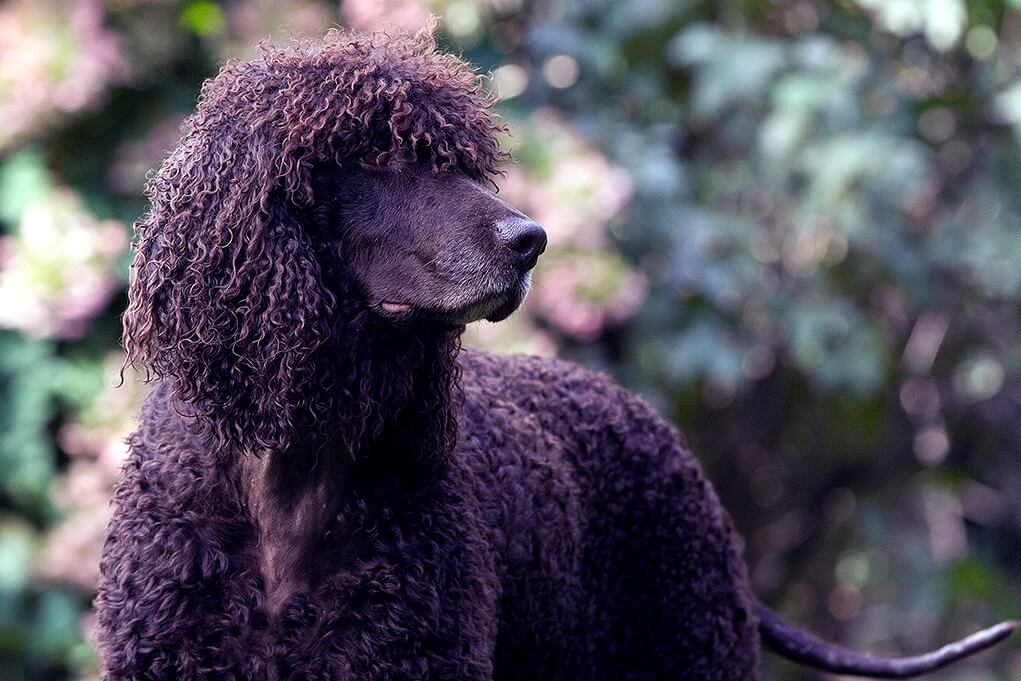





Regarded as the tallest of the American Kennel Club’s recognized spaniel breeds, the Irish Water Spaniel is further distinguished from its cousins by a distinctive topknot, crisply curled coat, and tapering “rat tail.” Originally bred in Ireland as a versatile and skilled retriever of waterfowl and upland birds, the breed remains adept at flushing and retrieving game birds on land and in the water. Known for their loyalty and trainability, these dogs can make extraordinary companions for active households that are able to accommodate the breed’s high energy and grooming needs. Most IWS adapt well to family life, expressing both their intelligence and their sensitivity in everything they do.
Sporting
21 – 24 inches
45 – 68 pounds
12 – 13 years
| Country of Origin | Ireland |
|---|---|
| Bred For | Hunting, Waterfowl Retrieving |
| Known For | Topknot, Curly Coat, Rat Tail, Intelligence, Energetic Nature |
| Popularity | Low |
| Temperament | Smart, Eager, Inquisitive, Active |
| Activities | Hunting, Swimming, Conformation Shows, Dog Sports |
The Irish Water Spaniel (IWS) has a rich history and holds a special place in dogdom, particularly in its native Ireland. Standardized as a unique purebred in the early 19th century, the breed’s exact ancestry is a topic of intrigue among canine historians. There is a strong belief that the breed descended from the now-extinct Shannon Spaniel, with potential influences from other water dogs and spaniels of the time. These genetic contributions would have honed the breed’s renowned swimming prowess and the development of its unique, water-resistant curly coat, traits making it an exceptional retriever in aquatic environments.
The breed’s early and notable recognition by major kennel clubs like the American Kennel Club (AKC) in 1884, The Kennel Club (UK), and the Fédération Cynologique Internationale (FCI) underscores its importance and distinction in the canine world. The AKC’s recognition, in particular, signifies one of the earliest registrations of any breed in the United States, reflecting the Irish Water Spaniel’s established presence and popularity.
Beyond its physical attributes, the Irish Water Spaniel has been historically prized for its versatility. Initially bred for retrieving game from water, its skills were not limited to aquatic environments. The breed also excelled as a hunting companion on land, aided by its acute sense of smell and innate retrieving instincts. These traits made it an invaluable asset for hunters in various terrains.
Despite its early acclaim and versatility, the Irish Water Spaniel has become somewhat rare in modern times. Nonetheless, it continues to be a breed cherished by enthusiasts, particularly in Ireland and among those who appreciate its hunting capabilities. The breed’s striking appearance, characterized by its dense curly coat and a distinctive, tapering “rat tail,” still garners attention in both the show ring and in fieldwork.
A male Irish Water Spaniel typically stands at a height of about 22 to 24 inches at the withers, whereas a female is slightly smaller, usually measuring around 21 to 23 inches.
In terms of weight, a male generally weighs between 55 to 68 pounds, while a female typically falls in the range of 45 to 58 pounds.
The Irish Water Spaniel is a breed that epitomizes a harmonious blend of proportion and substance. These dogs possess a body that is slightly longer than it is tall, giving them a robust and balanced appearance. The chest is deep and strong, providing ample lung capacity, essential for their vigorous swimming activities. Their build exhibits a combination of power and endurance, ensuring they can perform tirelessly whether in the field or water. Musculature is well-developed, yet not overly bulky, allowing for agility and speed. The overall appearance of the Irish Water Spaniel is one of a well-built, athletic dog, capable of performing the demanding tasks for which it was originally bred.
Texture: The Irish Water Spaniel is adorned with a distinctive double coat that is both functional and visually striking. The outer coat is comprised of dense, tight curls that are waterproof, providing an excellent protective layer when the dog is working in water. This curly coat covers the body, legs, and top of the head, while the face features smoother, shorter hair. The texture of the coat is neither wooly nor silky but lies somewhere in between, giving the breed its unique feel and appearance. The undercoat is thick and soft, adding an extra layer of insulation which is especially beneficial in cold water environments.
| Standard Color | |
|---|---|
| Liver | ee |
The Irish Water Spaniel does not have any recognized markings. The solid liver color is a defining characteristic of the breed, contributing to its distinct and singular appearance in the field and the Conformation show ring.
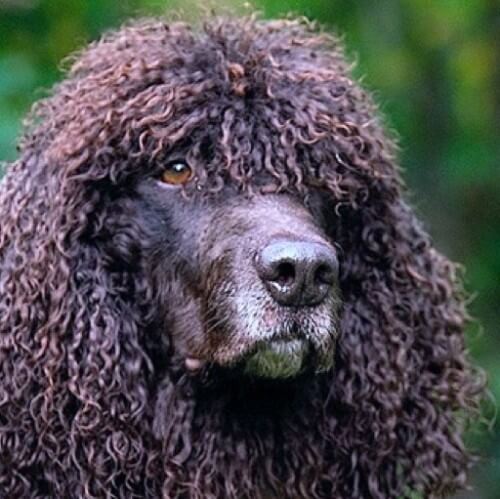
The tail of the Irish Water Spaniel is one of its most distinctive and defining features, often referred to as a “rat tail.” This unique characteristic sets the breed apart from other spaniels and water dogs. The tail is relatively short and thick at the base, tapering to a fine point. This tapering gives it the appearance of a rat’s tail, from which it gets its nickname. The base of the tail is covered with dense curls similar to those on the body, but as it tapers towards the end, the hair becomes smooth and short, giving it a distinct, sleek look.
The Irish Water Spaniel’s tail is typically carried level with the back or slightly higher, but it is not curled over the back. This posture reflects the breed’s alert and active nature. In the show ring, the tail’s unique appearance is a point of focus, as it exemplifies one of the breed’s most iconic and distinguishing traits.
When considering the Irish Water Spaniel as a companion, potential owners should be mindful of the breed’s distinct characteristics and care requirements. This breed, known for its intelligence and energy, thrives in an environment where it can engage both physically and mentally. They are well-suited for active families or individuals who enjoy outdoor activities and can provide ample opportunities for exercise and stimulation.
The Irish Water Spaniel is generally a healthy breed with a lifespan that typically ranges between 12 to 13 years. Like all breeds, it is prone to certain health conditions, but with proper care, regular veterinary check-ups, and a healthy lifestyle, many of these issues can be managed or prevented.
Irish Water Spaniels, like any breed, have predispositions to certain health conditions. Awareness and proactive management of these risks can contribute significantly to the overall health and longevity of these dogs. Some of the common health issues that Irish Water Spaniel caretakers should be aware of include:
It’s important for caretakers to schedule regular veterinary check-ups, as early detection and management of these conditions can significantly improve the quality of life for an Irish Water Spaniel. A balanced diet, regular exercise, and genetic screening, where available, are also crucial in maintaining their health.
The Irish Water Spaniel is a breed renowned for its vivacious and playful personality. These dogs are intelligent and quick learners, which makes them generally well-suited for both experienced and novice dog owners. Their intelligence, however, also means they can be independent thinkers, requiring consistent and positive training methods.
Sensitive by nature, Irish Water Spaniels respond best to positive reinforcement and can be quite receptive to their handler’s mood and tone. Harsh training methods are likely to be counterproductive. They are known for being loyal and affectionate with their families, often forming strong bonds.
When it comes to being alone, the Irish Water Spaniel can adapt, but like most dogs, they prefer company. Prolonged periods of isolation can lead to boredom and potentially destructive behavior, so mental and physical stimulation is important. They generally get along well with other dogs, especially when socialized from a young age.
Irish Water Spaniels are typically good with children, showing a gentle and playful demeanor. However, as with any breed, interactions between dogs and young children should always be supervised.
In terms of friendliness towards strangers, they can be somewhat reserved. Proper socialization from a young age is key to helping them become well-adjusted, confident adult dogs. They are not known to be overly aggressive but can be assertive if they perceive a threat to their family or territory.

Feeding and nutrition are critical aspects of caring for an Irish Water Spaniel, a breed known for its energy and athleticism. The dietary needs of an Irish Water Spaniel will vary depending on its age, size, metabolism, and activity level. It’s essential to tailor their diet to their individual needs to maintain optimal health.
For Irish Water Spaniel puppies, a diet formulated for large-breed puppies is often recommended. These formulations ensure that puppies receive the appropriate nutrients for their rapid growth phase without promoting excessive growth, which can lead to joint problems. Puppies typically require more frequent meals, approximately three to four times a day.
As they transition into adulthood, the frequency of meals can be reduced. Adult Irish Water Spaniels generally do well with two meals per day. The amount of food, usually measured in cups per day, should be based on the dog’s size and energy expenditure. Active dogs will require more calories, while less active dogs may need fewer to maintain a healthy weight.
Obesity can be a concern in the breed, particularly if they are not getting enough exercise. Therefore, monitoring their food intake and ensuring they get regular physical activity is crucial. Treats should be given in moderation and accounted for in the dog’s total daily calorie intake.
Fresh water should always be available, especially since these dogs may expend a lot of energy during play and exercise.
Consulting with a veterinarian to determine the most appropriate diet for an Irish Water Spaniel is advisable. They can provide guidance on the type and amount of food that is best suited for the dog’s specific needs, considering factors like age, health status, and activity level. A well-balanced diet, tailored to their individual requirements, is key to keeping an Irish Water Spaniel healthy, happy, and active.
Training an Irish Water Spaniel can be a rewarding experience, given their intelligence and eagerness to please. This breed is known for its quick learning ability, making them relatively easy to train, especially for handlers who establish a consistent and positive training routine.
Their intelligence, however, also means that Irish Water Spaniels can be independent thinkers. This trait calls for a training approach that is both firm and gentle. They respond best to positive reinforcement techniques such as praise, play, and treats. Harsh or negative training methods are likely to be counterproductive and could harm the bond between the dog and its handler.
The Irish Water Spaniel’s tendency to bark varies among individuals. Some may be more vocal, especially when they’re bored or not getting enough exercise. Training them from a young age to understand commands like ‘quiet’ can be beneficial in managing this behavior.
In terms of intelligence, this breed ranks high. They are capable of learning a wide variety of commands and tasks, making them suitable for advanced training and dog sports. Their problem-solving skills are notable, and they enjoy challenges that stimulate their minds.
Wanderlust potential in Irish Water Spaniels is moderate. While they might be curious about their surroundings, proper training and a secure environment can keep their exploring instincts in check. It’s essential to provide them with a safe and enclosed space where they can play and exercise without the risk of wandering off.
Predatory instincts can be present, especially given their hunting background. Training and socialization from an early age can help manage these instincts, especially around smaller animals and pets.
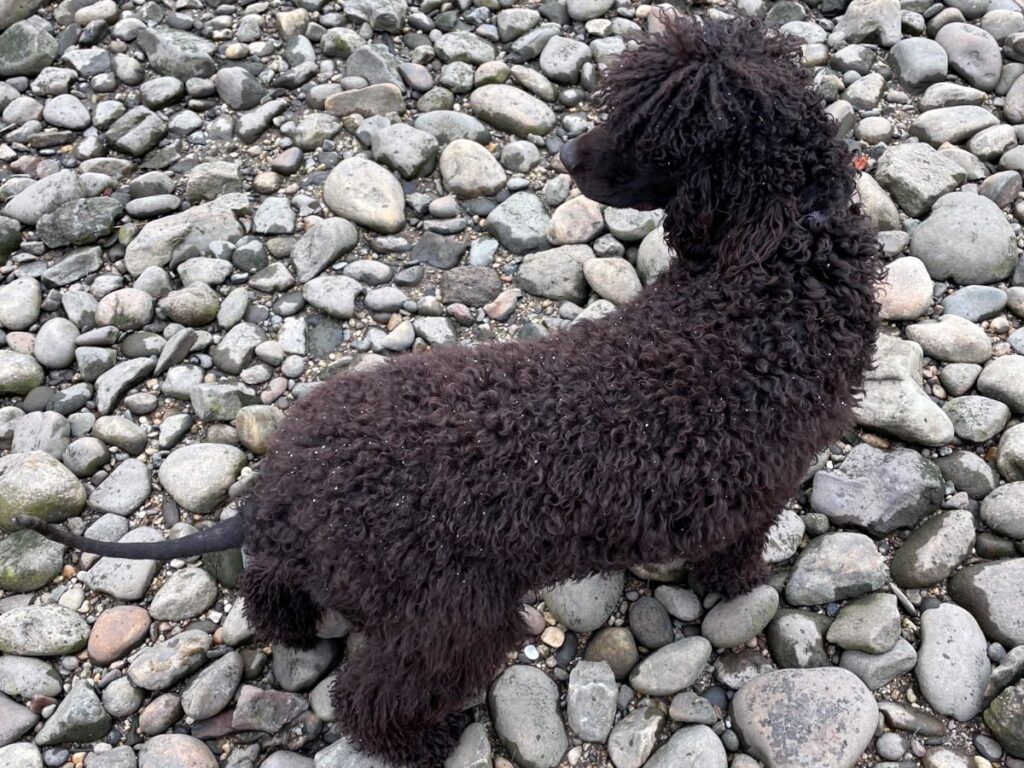
Exercise is a crucial aspect of the Irish Water Spaniel’s daily routine, given their high energy levels and athletic build. This breed thrives on physical activity and requires regular exercise to maintain its physical and mental well-being.
| Energy Level | High |
|---|---|
| Exercise Requirements | 2 Hours/Day (Minimum), Daily Walks, Weekly Swimming, Vigorous Running, Playing with Another Dog, Mental Stimulation |
The exercise needs of an Irish Water Spaniel are relatively high. They are energetic dogs that enjoy a variety of activities, including swimming, running, and playing fetch. These activities not only cater to their physical needs but also provide mental stimulation, which is essential for this intelligent breed.
When it comes to energy level, the Irish Water Spaniel is typically very lively and spirited. They possess a natural enthusiasm for activity, making them great companions for outdoor adventures such as hiking, jogging, and water sports. Their love for water is particularly notable, and they excel in activities that involve swimming.
The intensity of their exercise should match their high energy levels. However, it’s important to balance vigorous activities with periods of rest to prevent overexertion. As puppies, their exercise should be moderate to protect their developing bones and joints.
Playfulness is another characteristic of the Irish Water Spaniel. They enjoy interactive play sessions, which can be a fun way to provide exercise and strengthen the bond between the dog and its handler. Incorporating play into their exercise routine can keep them engaged and happy.
It’s essential for caretakers to understand the exercise requirements of this breed. An Irish Water Spaniel that doesn’t receive adequate exercise may exhibit behavioral issues, such as excessive barking or destructiveness, stemming from boredom or pent-up energy. Regular, structured exercise is key to keeping an Irish Water Spaniel healthy, both physically and mentally. This commitment to their exercise needs makes them most suitable for active individuals or families who can integrate the dog into their active lifestyle.
Grooming is an essential aspect of caring for an Irish Water Spaniel, a breed known for its distinctive curly coat and specific grooming needs. Regular grooming not only keeps the dog looking its best but also promotes good skin and coat health.
| Coat Type | Dense, Tight, Curly |
|---|---|
| Grooming Requirements | Weekly Brushing, Occasional Bathing, Routine Ear Cleaning, Periodic Nail Trimming, Regular Tooth Brushing |
The coat of an Irish Water Spaniel is naturally water-resistant and consists of tight, crisp ringlets. This unique coat requires regular maintenance to prevent matting and tangling. Brushing the coat at least once a week is recommended to remove dead hair and distribute natural oils throughout the coat. During shedding seasons, more frequent brushing may be necessary to manage increased hair loss.
In terms of ease of grooming, the Irish Water Spaniel’s coat can be somewhat challenging due to its texture and tendency to mat. Caretakers should be prepared to invest time in regular grooming sessions. Professional grooming every few months can be beneficial, especially for trimming and maintaining the proper coat shape.
Shedding in Irish Water Spaniels is generally moderate. While they do shed, their curly coat tends to trap loose hair, which can be easily removed with regular grooming. This characteristic may make them a slightly better option for individuals with mild allergies, though no breed is completely hypoallergenic.
Bathing the Irish Water Spaniel should be done as needed. Due to their love for water and outdoor activities, they may require baths more frequently than some other breeds, especially if they are prone to getting muddy or swimming in natural bodies of water. It’s important to use a dog-specific shampoo that is gentle on their skin and coat.
In addition to coat care, regular grooming also includes nail trimming, ear cleaning, and dental care. Their ears, in particular, require attention due to their size and shape, which can predispose them to ear infections. Regular ear cleaning and checking for signs of infection are important.

Living with an Irish Water Spaniel can be a delightful experience, but it requires understanding and accommodating their specific needs. This breed’s adaptability makes it suitable for various living conditions, but there are certain considerations to keep in mind.
Adapting to life with an Irish Water Spaniel in an apartment setting requires dedicated effort to meet their exercise and stimulation needs. These energetic dogs thrive when they have ample space and opportunities for physical activity. For those living in apartments, it’s essential to commit to regular, vigorous exercise routines, including long walks, runs, and playtime in spacious outdoor areas. Mental stimulation, through interactive toys and training exercises, is also crucial in keeping them engaged and preventing boredom.
In terms of adaptability to weather conditions, the Irish Water Spaniel’s dense, curly coat provides good insulation, making them fairly tolerant of cold weather. However, it’s important to make sure that they are not exposed to extreme cold for prolonged periods, as with any dog. In contrast, their coat can make them prone to overheating in hot weather. During warmer months, it’s crucial to provide them with plenty of water, shade, and opportunities to cool off, such as swimming, which they naturally enjoy.
The Irish Water Spaniel’s adaptability extends to family life as well. They are known for being loyal and affectionate companions, fitting well into family settings. However, due to their size and energy levels, supervision is advisable when they are interacting with young children. Proper socialization and training from a young age are essential to make sure that they are well-behaved and sociable.
Welcoming an Irish Water Spaniel puppy into your home is an exciting and rewarding experience, filled with challenges and joys. These puppies are known for their playful and curious nature, and they bring a lot of energy and enthusiasm into any household. From the moment an Irish Water Spaniel puppy arrives, it begins a journey of growth and discovery, both for the puppy and its new family.
Caring for an Irish Water Spaniel puppy involves several important aspects to ensure their healthy development and well-being. Initially, creating a safe and welcoming environment is crucial. Puppies are naturally curious and will explore their surroundings, so it’s important to puppy-proof your home, removing any hazardous objects they might chew on or swallow.
Nutrition plays a vital role in the puppy’s growth. Feeding them high-quality puppy food formulated for medium to large breeds is recommended to support their development. The feeding should be spread over multiple meals throughout the day, as puppies have small stomachs and high energy needs.
Socialization and training should start early. Exposing them to different people, environments, and situations helps in developing a well-rounded and confident adult dog. Positive reinforcement techniques work best for training, as they encourage learning and strengthen the bond between the puppy and its owner.
Regular veterinary check-ups are essential to monitor the puppy’s health, including vaccinations and preventive treatments for parasites. It’s also the perfect time to discuss and plan for spaying or neutering.
Exercise for Irish Water Spaniel puppies should be moderate and appropriate for their age. Too much exercise can be harmful to their developing bones and joints. Short walks, play sessions, and swimming are excellent ways to expend energy and keep them fit.
Lastly, grooming habits should be established early. Regular brushing helps the puppy get accustomed to being handled and keeps their coat in good condition. It also provides an opportunity to check for any skin issues or parasites.
Irish Water Spaniels, with their high energy levels and intelligent nature, excel in various dog sports and activities. Engaging them in these activities is not only a great way to meet their exercise needs but also provides mental stimulation and strengthens the bond between the dog and its handler.
Performance dog sports are particularly well-suited for this breed, given their athletic abilities and eagerness to learn. Some of the sports in which Irish Water Spaniels commonly participate include:
These activities not only provide physical and mental stimulation for the Irish Water Spaniel but also offer opportunities for socialization and community involvement. Engaging an Irish Water Spaniel in these activities can lead to a fulfilling and enriching life for both the dog and its human companion.
The French Bulldog is recognized by the world’s leading registries and kennel organizations, which categorize the breed into a specific Group based on its unique characteristics. This breed is recognized worldwide under the following Group designations:
| Organization | Group Designation |
|---|---|
| AKC (American Kennel Club) | Sporting |
| UKC (United Kennel Club) | Gun Dog |
| CKC (Canadian Kennel Club) | Sporting Dogs |
| ANKC (Australian National Kennel Council) | Gundogs |
| RKC (The Royal Kennel Club) | Gundog |
| FCI (Fédération Cynologique Internationale) | Group 8: Retrievers, Flushing Dogs, Water Dogs; Section 3: Water Dogs |
The ideal French Bulldog is described by a Breed Standard that is approved by each of the world’s leading registries and kennel organizations. The Breed Standards for this breed may be found in the following links:
| Organization | Breed Standard |
|---|---|
| American Kennel Club | AKC Irish Water Spaniel Breed Standard |
| United Kennel Club | UKC Irish Water Spaniel Breed Standard |
| Canadian Kennel Club | CKC Irish Water Spaniel Breed Standard |
| Australian National Kennel Council | ANKC Irish Water Spaniel Breed Standard |
| The Royal Kennel Club | RKC Irish Water Spaniel Breed Standard |
| Fédération Cynologique Internationale | FCI Irish Water Spaniel Breed Standard |
Involvement in Irish Water Spaniel clubs can be a valuable resource for owners and enthusiasts of the breed. These clubs offer support, resources, and a community of like-minded individuals who share a passion for the Irish Water Spaniel.
In the USA, The Irish Water Spaniel Club of America (IWSCA) is the primary organization dedicated to the breed. The IWSCA focuses on the promotion, protection, and preservation of Irish Water Spaniels, providing a platform for education, breed health, and responsible ownership.
In Canada, the Irish Water Spaniel presence is represented by The Irish Water Spaniel Association of Canada. This organization similarly works to promote the breed, offering resources and support for breeders, owners, and enthusiasts, and helps in maintaining the breed’s standards and health in the Canadian context.
In the United Kingdom, the Irish Water Spaniel Association is the key organization dedicated to the breed. It functions similarly to its American and Canadian counterparts, offering resources and support for breeders, owners, and enthusiasts, while also promoting the breed’s health and welfare.
Membership in these clubs is open to anyone with an interest in the breed, whether they are current owners, prospective owners, or simply admirers of the Irish Water Spaniel. Being part of these clubs can be immensely rewarding, offering educational resources, opportunities for involvement in breed-specific activities, and a sense of community among those who share a love for the Irish Water Spaniel.
Rescue groups play a crucial role in the wellbeing of Irish Water Spaniels, offering a second chance to those in need. These organizations are dedicated to the rescue, rehabilitation, and rehoming of Irish Water Spaniels, ensuring that these dogs receive the care and love they deserve.
In the USA, The Irish Water Spaniel Club of America (IWSCA) includes efforts in rescue as part of its commitment to the breed. The club works to provide support for Irish Water Spaniels that have been lost, abandoned, or surrendered. The IWSCA not only facilitates adoption services but also invests in education and resources to help prevent future abandonment and mistreatment of these dogs.
In Canada, The Irish Water Spaniel Association of Canada, and in the United Kingdom, the Irish Water Spaniel Association play a significant role in supporting Irish Water Spaniels in need. These clubs work towards the welfare of these dogs, providing necessary care and actively seeking suitable homes where they can thrive.
In addition to national or regional breed clubs and general rescue groups, prospective owners are also encouraged to consider local shelters and broader animal rescue organizations. These shelters often have a variety of breeds and mixed-breed dogs, including occasionally Irish Water Spaniels, in need of loving homes.
Irish Water Spaniels are often considered hypoallergenic, though it’s important to note that no dog breed is completely hypoallergenic. They have a dense, curly coat that tends to trap dander and requires regular grooming to maintain. Due to their coat type, they typically produce less dander than many other breeds, which can be beneficial for people with mild allergies to dogs.
Irish Water Spaniels are known for their low-shedding coats, making them a popular choice for those seeking a breed that won’t leave much hair around the house. Their tight, curly fur minimizes the amount of hair they shed. However, regular grooming is essential to prevent matting and to keep their coat in good condition.
Irish Water Spaniels are generally not known for being aggressive. They are typically friendly and outgoing dogs. Like any breed, their temperament can be influenced by a variety of factors, including genetics, training, and socialization. It’s important for owners to provide them with early socialization and consistent, positive training to promote good behavior.
Irish Water Spaniels can make excellent pets for the right household. They are intelligent, energetic, and affectionate dogs that enjoy being part of the family. These dogs thrive with regular exercise and mental stimulation, which makes them an ideal match for active individuals or families. Their friendly nature and trainability also make them well-suited for families with children, as they can integrate well into various home environments that provide the necessary engagement and care.
While Irish Water Spaniels are hardy and adaptable, they thrive best when they are part of the family and live indoors. They are social animals that form strong bonds with their owners and can become lonely or stressed if left outside for extended periods. Adequate shelter, regular interaction, and mental stimulation are essential for their well-being if they spend any significant time outdoors.
Irish Water Spaniels are a medium to large breed. Males typically stand about 22 to 24 inches at the shoulder and weigh between 55 to 68 pounds, while females are slightly smaller. Their size, combined with their curly coat and athletic build, gives them a distinctive and robust appearance.
An Irish Water Spaniel typically lives for about 12 to 13 years. Like all breeds, their longevity can be affected by several factors such as genetics, diet, exercise, and the quality of veterinary care. Regular check-ups, a balanced diet, and an active lifestyle can contribute to a longer, healthier life for these dogs.

Explore in the world of an Irish canine painter, Louisa Nally, who captures the essence of Irish native breeds and gundogs in her art.
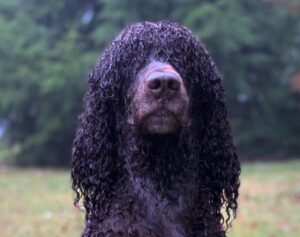
Learn about the importance of the unique coat of the Irish Water Spaniel, from its texture to its pattern and color.

Stacy Duncan is the breeder behind Flintcrest Irish Water Spaniels. Read about the kennel’s beginnings, the sires, the dams, and more!

Mark Barker, DVM, and Sondra Barker are the breeders behind Sycomore Irish Water Spaniels. Read about the kennel’s beginnings and more!
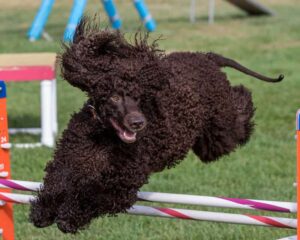
It’s fantastic to have a dog that has high-level titles on both ends. Learn how this can be done even with limited time and resources.
Dan Sayers: Where do I live? How many years in dogs? How many years as a breeder? I live in Merchantville, New Jersey, near Philadelphia.
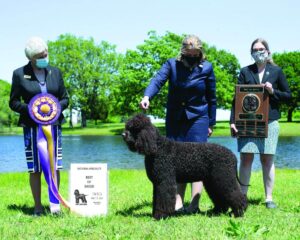
Irish Water Spaniel | Rat Tail Spaniel Clan – The Post Oak Lodge and Retreat, situated in the rolling hills of Northeastern Oklahoma.

Dan Sayers is the Editor-in-Chief of SHOWSIGHT digital and print publications. He received a B.S. from Drexel University where he studied interior architectural design. His professional career has allowed him to develop his planning, problem-solving, and project management skills, which were employed in the office, educational, and financial sectors. While working as a project manager, he earned a Graphic Design Certificate from the University of the Arts and began creating ads for many of America’s top-winning show dogs. Through this work, Dan became Editor-in-Chief of the nation’s first online-only dog show publication. His current role expands on this experience and broadly extends to cover the sport of dogs in Companion and Performance events as well as all aspects of Conformation.
Dan is a long-time member of the Irish Water Spaniel Club of America and is the organization’s current AKC Delegate and Archivist/Historian, as well as a club-approved Breed Mentor. From 2000-2010, he was the club’s AKC Gazette Columnist. He breeds Irish Water Spaniels under the Quiet Storm prefix and has judged the IWSCA National Specialty Sweepstakes twice. Dan is a member of the Morris and Essex Kennel Club as well as the Dog Writers Association of America, which recognized his illustrations in the award-winning canine compendium, the Encyclopedia of K-9 Terminology.
The best way to ensure a long and happy relationship with a purebred dog is to purchase one from a responsible breeder. Not sure where to begin?
Contact the National Parent Club’s Breeder Referral Program, which is listed on the AKC Breeder Referral Contacts page.
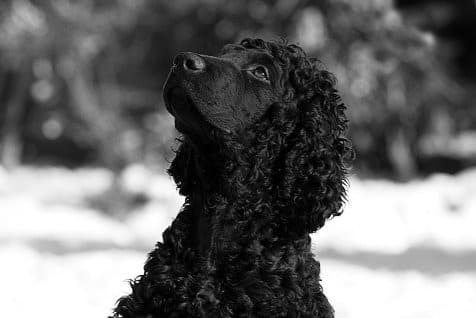

"*" indicates required fields
Showsight Magazine–the world’s most influential purebred dog publication since 1992. Each issue reaches a global audience dedicated to preserving the history and health of purpose bred dogs. Filled with award-winning editorial focused on news and insights from the dog show community, top breeders, handlers, AKC Judges, and more!